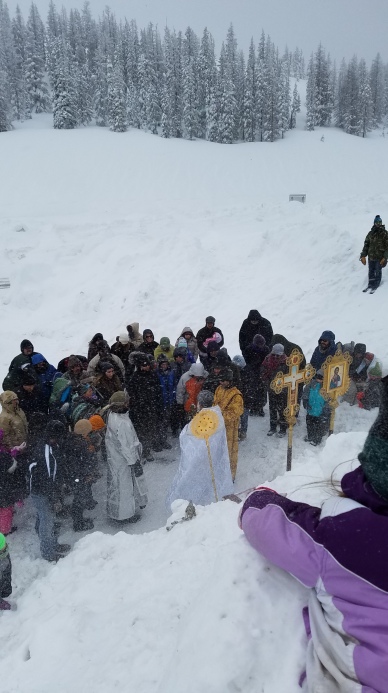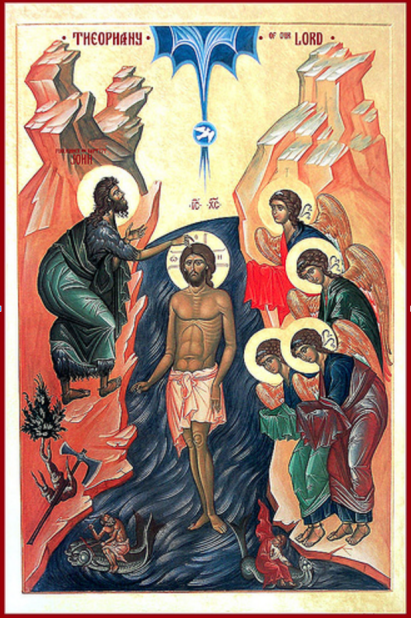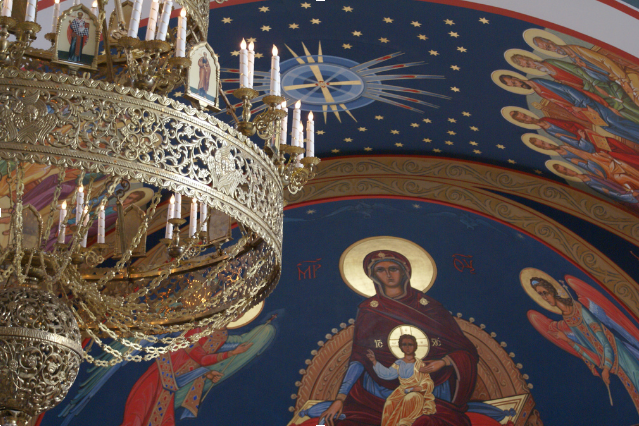 Given my general focus on typology on this blog, I thought it apropos to say something about the typology evident in the Orthodox feast of Holy Theophany (our parish’s patronal feast), or Christ’s baptism. Today our family made the trek with many others from our parish to the continental divide at Monarch Pass to participate in the blessing of the waters that traditionally follows the feast. It was rather cold and blustery, but a blessing that extends to both sides of the continent. The water blessing typically takes place on the day of the feast, but we delayed this particular event to make it easier for more to attend.
Given my general focus on typology on this blog, I thought it apropos to say something about the typology evident in the Orthodox feast of Holy Theophany (our parish’s patronal feast), or Christ’s baptism. Today our family made the trek with many others from our parish to the continental divide at Monarch Pass to participate in the blessing of the waters that traditionally follows the feast. It was rather cold and blustery, but a blessing that extends to both sides of the continent. The water blessing typically takes place on the day of the feast, but we delayed this particular event to make it easier for more to attend.
A glimpse of the magnitude interdependence between the two Testaments can be experienced through even a cursory examination of the feast of Holy Theophany, since so many Old Testament types foreshadow baptism. Saint Mark’s account of Christ’s baptism sets the stage for the blessing of the waters following the Divine Liturgy. Leading up to the blessing, prophecies from the book of Isaiah proclaim the coming of the Messianic age, repeatedly employing the imagery of water satiating the thirst of that which is dry, transforming deserts into oases.
Immediately before the enactment of the blessing, we encounter four Old Testament types prefiguring the baptism of our Lord.
You are our God, who drowned sin in the waters at the time of Noah.
You are our God, who in the sea, and at the hands of Moses, delivered the Hebrews from the bondage of Pharaoh.
You are our God who cleaved the rock in the wilderness, so that the waters gushed out, and the streams overflowed, and your thirsty people were satisfied.
You are our God who, with fire and water and at the hands of Elijah, delivered Israel from the errors of Baal.1
These verses awaken the memory of the previous night’s services (usually) incorporating Old Testament passages that illustrate some of these and other types in detail. For instance, excerpts from Exodus 14 portray the miraculous Israelite crossing of the sea and the devastating destruction of their Egyptian pursuers in the waters of the sea, clearly in agreement with Saint Gregory’s typology in The Life of Moses. The story of the Prophet Elias defeating the prophets of Baal is conveyed through the reading of 1 Kings 18:30-39.2
 During these evening services, the reality of Theophany is explicitly connected with the events described in these ancient Scriptures by the Apostle Paul:
During these evening services, the reality of Theophany is explicitly connected with the events described in these ancient Scriptures by the Apostle Paul:
Moreover, brethren, I would not that ye should be ignorant, how that all our fathers were under the cloud, and all passed through the sea; And were all baptized unto Moses in the cloud and in the sea; And did all eat the same spiritual meat; And did all drink the same spiritual drink: for they drank of that spiritual Rock that followed them: and that Rock was Christ (1 Corinthians 10:14).
Recalling the day’s Liturgical Epistle reading of Titus 2:11-14, we learn of the consequences of Theophany. God came to earth so “that he might redeem us from all iniquity, and purify unto himself a peculiar people, zealous of good works.” It seems that the Old Testament foretells the event, the Gospel narrates the event itself, while the Epistle exposes the outcome.3
Finally, when the celebrant enacts the blessing upon the water, he immerses the Cross into the water three times (ok, ours was snow), evoking the reading of Exodus 15 from the previous evening telling the story of the waters of Marah. The wood that sweetened the waters of Marah clearly foreshadows the wood of the cross and the cleansing of the water in Christ’s baptism. But the act also typifies Christ’s baptism and unites the types and their antetype into a single physical action, immersing the participants in a direct experiential encounter with the reality.
The Church, in the troparion of the feast and in the icon of the feast, elucidates the ultimate revelation of Theophany. The Trinity, which we saw foreshadowed in Elijah’s threefold baptism of his sacrifice, is fully apprehended in both the icon and the Troparion, clearly portraying the Gospel event. The icon depicts the glory of the Father sending down the Holy Spirit in the form of a dove to Christ who stands in the Jordan, the river parted so many times by Christ himself. The troparion makes the understanding explicit:
When Thou, O Lord, wast baptized in the Jordan the worship of the Trinity was made manifest! For the voice of the Father bare witness to Thee, calling Thee his Beloved Son. And the Spirit, in the form of a dove, confirmed the truthfulness of his Word. O Christ our God, who hast revealed Thyself and hast enlightened the world, glory to Thee.4
In this feast Old Testament passages are used in multiple ways. We experience prophecy or promise, as in the Prophecies of Isaiah, pointing to the fulfillment in the Baptism of Christ and in our own baptisms in Christ. We also experience the antetype through a rich portrayal of Old Testament types, partly in the words of the blessing itself, but more fully in the prior evening’s services. Gospel passages portray the antetype itself and Epistle readings explicitly connect the types with their antetype in order to provide clarity. The Epistle readings also help to explain the consequences of Theophany. Finally, all are united experientially in the liturgical action of the blessing of the waters and in the depiction of the event in the Holy Icon.
The Gospel seems to be the vortex around which all other scriptures swirl. The event of Theophany impacts both the past and the future, sending ripples in all directions through the fabric of space-time. The experience of the feast itself is outside of time and we experience it through direct participation.
1 John Sanidopoulos, “The Theophany Sanctification Prayer of St. Sophronios of Jerusalem”, Mystagogy: The Weblog of John Sanidopoulos (http://www.johnsanidopoulos.com/2011/01/theophany-sanctification-prayer-of-st.html) .
2 “Readings for Theophany – January 6”, Byzantine Catholic Church in America (http://www.byzcath.org/etc/Theophany_Readings.pdf) .
3 Fr. Thomas Hopko, “Epiphany”, in The Orthodox Faith: Volume II – Worship (http://oca.org/orthodoxy/the-orthodox-faith/worship/the-church-year/epiphany) .
4 Ibid.
